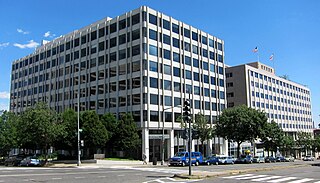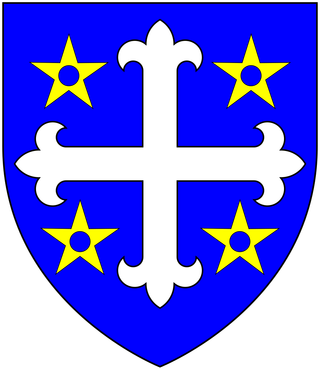The Charity Commission for England and Wales is a non-ministerial department of His Majesty's Government that regulates registered charities in England and Wales and maintains the Central Register of Charities. Since the 2000s, governance of charities in the United Kingdom has been devolved; operating in other parts of the country are the Office of the Scottish Charity Regulator and the Charity Commission for Northern Ireland.

An almshouse is charitable housing provided to people in a particular community, especially during the Middle Ages. They were often targeted at the poor of a locality, at those from certain forms of previous employment, or their widows, and at elderly people who could no longer pay rent, and are generally maintained by a charity or the trustees of a bequest. Almshouses were originally formed as extensions of the church system and were later adapted by local officials and authorities.

East Coker is a village and civil parish in the South Somerset district of Somerset, England. Its nearest town is Yeovil, two miles (3.2 km) to the north. The village has a population of 1,667. The parish includes the hamlets and areas of North Coker, Burton, Holywell, Coker Marsh, Darvole, Nash, Keyford as well as the southern end of the Wraxhill area.

A charitable organization or charity is an organization whose primary objectives are philanthropy and social well-being.
Parmiter's School is a co-educational state comprehensive school with academy status in Garston, Hertfordshire, close to the outskirts of North West London, England with a long history. Although the school admits pupils of all abilities it is partially selective. It is currently the most oversubscribed school in Hertfordshire, and has often been recognised by the Department for Education and Skills (DfES) for being one of the highest-performing schools in the country by value added and score as a mixed-ability school.

The Hospital of St Cross and Almshouse of Noble Poverty is a medieval almshouse in Winchester, Hampshire, England. It has been described as "England's oldest and most perfect almshouse". Most of the buildings and grounds are open to the public at certain times. It is a Grade I listed building.

John Nost was a Flemish sculptor who worked in England in the late 17th and early 18th centuries.

Clergy Support Trust is a charity which provides support to Anglican clergy and ordinands, and their families, in the UK and Ireland.

Brian Duppa was an English bishop, chaplain to the royal family, Royalist and adviser to Charles I of England.

George Coke or Cooke was successively the Bishop of Bristol and Hereford. After the battle of Naseby in 1645, Hereford was taken and Coke was arrested and taken to London. He avoided charges of High Treason in January 1646 and died in Gloucestershire that year.

Coker Court is a substantial manor house in East Coker, Somerset, England. It was built in the fifteenth and eighteenth centuries and has been designated as a Grade I listed building. It was erected by the Courtney family who were lords of the manor and rectors of the adjacent parish church. The building is constructed from locally quarried Hamstone with roofs composed of stone tiles.

William Helyar of Coker Court, East Coker, in Somerset, was Archdeacon of Barnstaple and a chaplain to Queen Elizabeth I.

Miss Cullen's Almshouses in Carrington, Nottingham is a complex of 12 almshouses erected in 1882-83. They are also known as the Cullen Memorial Homes.

The Monmouth Alms Houses of Monmouth, Wales are funded by the charity established by the haberdasher William Jones before his death in 1615. That charity also established schools in Monmouth and a lectureship in London. The Haberdashers' Company served as trustee of the charity from 1613 until 2011, when the trusteeship was transferred to Bristol Charities. A second charity established through a separate bequest by Jones enabled the building of the Newland Alms Houses in the Forest of Dean. The original Monmouth Alms Houses were constructed in 1614; they were rebuilt in 1842 and 1961. The fourth version of the Monmouth Alms Houses was completed in 2013 and is named 'Cwrt William Jones Almshouses' and is owned and managed by Bristol Charities under the name of 'William Jones Almshouse Charity'. The original alms houses were located on what is now known as Almshouse Street. The most recent houses are located off St James' Square.
Henry Bridgeman was an Anglican clergyman who served in the Church of England as the Bishop of Sodor and Man from 1671 to 1682.

Hickey's Almshouses are almshouses between Sheen Road and St Mary's Grove in Richmond, London.

St Michael and All Angels’ Church is a Grade II* listed parish church in the Church of England in East Coker, Somerset.

Canonteign is an historic tything in the parish of Christow, near Chudleigh, in South Devon, England and situated in the valley of the River Teign. The 'canon' in the name refers to the Augustinian canons regular, either of St Mary du Val in Normandy or of Merton Priory, which owned it for several centuries. It is best known today for the Canonteign Falls waterfall. Canonteign today contains three significant houses: the original Grade I listed 16th-century manor house, the ancient barton house situated nearby behind a granite wall, and a new mansion house built by the Pellew family in the early 19th century nearby, to which that family moved their residence thereby abandoning the old manor house.
The William Portman Almshouses in Staple Fitzpaine, Somerset, England was built in 1643. It is a Grade II* listed building.
















